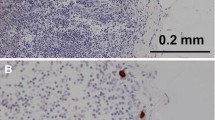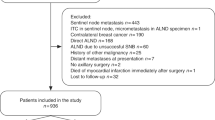Abstract
Background
Isolated tumor cells (ITC) are more likely to be identified when serial sectioning and immunohistochemical staining are used to evaluate sentinel lymph nodes (SLN). Our goal was to identify clinicopathologic features associated with ITC in patients undergoing sentinel lymph node dissection (SLND).
Methods
We reviewed clinicopathologic data for 3557 patients with no clinical evidence of lymph node metastases undergoing SLND between November 1993 and March 2007. Patients were staged according to the 6th edition of the American Joint Committee on Cancer staging system, with metastasis ≤.2 mm classified as ITC.
Results
A SLN was identified in 3475 patients (97.7%), including 2518 (72.4%) with negative nodes and 169 (4.9%) with ITC. A statistically significant association existed between lobular histology and the identification of ITC; 13.6% of patients with ITC had lobular histology versus 7.3% of patients with a negative SLN (P = .003). The presence of lymphovascular invasion (LVI) was also associated with ITC; 18.3% of patients with ITC had LVI in the primary tumor versus 8.5% of patients with a negative SLN (P < .001). No difference existed between patients with and without ITC with respect to T stage, grade, estrogen receptor, progesterone receptor, HER2/neu status, or biopsy method.
Conclusion
The association between ITC and LVI, a known predictor of poor outcome, suggests ITC may have clinical relevance. The relationship between lobular histology and ITC is consistent with the known pattern of lobular metastases, which frequently present as small foci requiring immunohistochemistry for detection. Longer follow-up is needed to determine whether ITC have prognostic significance.


Similar content being viewed by others
References
Mansel RE, Fallowfield L, Kissin M, et al. Randomized multicenter trial of sentinel node biopsy versus standard axillary treatment in operable breast cancer: the ALMANAC Trial. J Natl Cancer Inst 2006;98:599–609
Purushotham AD, Upponi S, Klevesath MB, et al. Morbidity after sentinel lymph node biopsy in primary breast cancer: results from a randomized controlled trial. J Clin Oncol 2005;23:4312–21
Veronesi U, Paganelli G, Viale G, et al. A randomized comparison of sentinel-node biopsy with routine axillary dissection in breast cancer. N Engl J Med 2003;349:546–53
Giuliano AE, Dale PS, Turner RR, et al. Improved axillary staging of breast cancer with sentinel lymphadenectomy. Ann Surg 1995;222:394–9
Liberman L. Pathologic analysis of sentinel lymph nodes in breast carcinoma. Cancer 2000;88:971–7
Boughey JC, Bedrosian I, Meric-Bernstam F, et al. Comparative analysis of sentinel lymph node operation in male and female breast cancer patients. J Am Coll Surg 2006;203:475–80
Cox C, White L, Allred N, et al. Survival outcomes in node-negative breast cancer patients evaluated with complete axillary node dissection versus sentinel lymph node biopsy. Ann Surg Oncol 2006;13:708–11
Greene FL, Page DL, Fleming ID, eds. (2002) Breast. In: AJCC Cancer Staging Manual, 6th edition. New York: Springer, pp 223–40
Krag DN, Julian TB, Harlow SP, et al. NSABP-32: phase III, randomized trial comparing axillary resection with sentinal lymph node dissection: a description of the trial. Ann Surg Oncol 2004;11:208S–10S
Weaver DL, Krag DN, Ashikaga T, et al. Pathologic analysis of sentinel and nonsentinel lymph nodes in breast carcinoma: a multicenter study. Cancer 2000;88:1099–107
American College of Surgeons Oncology Group (ASOCOG). Available at: www.acosog.org/. Accessed September 5, 2008
Breslin TM, Cohen L, Sahin A, et al. Sentinel lymph node biopsy is accurate after neoadjuvant chemotherapy for breast cancer. J Clin Oncol 2000;18:3480–6
Lambert LA, Ayers GD, Hwang RF, et al. Validation of a breast cancer nomogram for predicting nonsentinel lymph node metastases after a positive sentinel node biopsy. Ann Surg Oncol 2006;13:310–20
Yared MA, Middleton LP, Smith TL, et al. Recommendations for sentinel lymph node processing in breast cancer. Am J Surg Pathol 2002;26:377–82
Fisher ER, Swamidoss S, Lee CH, et al. Detection and significance of occult axillary node metastases in patients with invasive breast cancer. Cancer 1978;42:2025–31
Huvos AG, Hutter RV, Berg JW. Significance of axillary macrometastases and micrometastases in mammary cancer. Ann Surg 1971;173:44–6
Pickren JW. Significance of occult metastases. A study of breast cancer. Cancer 1961;14:1266–71
Cummings MC, Walsh MD, Hohn BG, et al. Occult axillary lymph node metastases in breast cancer do matter: results of 10-year survival analysis. Am J Surg Pathol 2002;26:1286–95
Nasser IA, Lee AK, Bosari S, et al. Occult axillary lymph node metastases in “node-negative” breast carcinoma. Hum Pathol 1993;24:950–7
Tan LK, Giri D, Hummer AJ, et al. Occult axillary node metastases in breast cancer are prognostically significant: results in 368 node-negative patients with 20-year follow-up. J Clin Oncol 2008;26:1803–9
Querzoli P, Pedriali M, Rinaldi R, et al. Axillary lymph node nanometastases are prognostic factors for disease-free survival and metastatic relapse in breast cancer patients. Clin Cancer Res 2006;12:6696–701
Hansen N, Grube B, Ye C, et al. The impact of micrometastases in the sentinel nodes of patients with invasive breast cancer. Breast Cancer Res Treat 2007;106(Suppl 1):S15
Cox CE, Kiluk JV, Riker AI, et al. Significance of sentinel lymph node micrometastases in human breast cancer. J Am Coll Surg 2008;206:261–8
Bleiweiss IJ, Nagi CS, Jaffer S. Axillary sentinel lymph nodes can be falsely positive due to iatrogenic displacement and transport of benign epithelial cells in patients with breast carcinoma. J Clin Oncol 2006;24:2013–8
Carter BA, Jensen RA, Simpson JF, et al. Benign transport of breast epithelium into axillary lymph nodes after biopsy. Am J Clin Pathol 2000;113:259–65
Diaz NM, Cox CE, Ebert M, et al. Benign mechanical transport of breast epithelial cells to sentinel lymph nodes. Am J Surg Pathol 2004;28:1641–5
Lee AK, Loda M, Mackarem G, et al. Lymph node negative invasive breast carcinoma 1 centimeter or less in size (T1a,bNOMO): clinicopathologic features and outcome. Cancer 1997;79:761–71
Leitner SP, Swern AS, Weinberger D, et al. Predictors of recurrence for patients with small (one centimeter or less) localized breast cancer (T1a,b N0 M0). Cancer 1995;76:2266–74
Mann GB, Port ER, Rizza C, et al. Six-year follow-up of patients with microinvasive, T1a, and T1b breast carcinoma. Ann Surg Oncol 1999;6:591–8
Quiet CA, Ferguson DJ, Weichselbaum RR, et al. Natural history of node-negative breast cancer: a study of 826 patients with long-term follow-up. J Clin Oncol 1995;13:1144–51
Shen J, Hunt KK, Mirza NQ, et al. Predictors of systemic recurrence and disease-specific survival after ipsilateral breast tumor recurrence. Cancer 2005;104:479–90
Rivers AK, Griffith KA, Hunt KK, et al. Clinicopathologic features associated with having four or more metastatic axillary nodes in breast cancer patients with a positive sentinel lymph node. Ann Surg Oncol 2006;13:36–44
Hwang RF, Krishnamurthy S, Hunt KK, et al. Clinicopathologic factors predicting involvement of nonsentinel axillary nodes in women with breast cancer. Ann Surg Oncol 2003;10:248–54
Van Zee KJ, Manasseh DM, Bevilacqua JL, et al. A nomogram for predicting the likelihood of additional nodal metastases in breast cancer patients with a positive sentinel node biopsy. Ann Surg Oncol 2003;10:1140–51
Bevilacqua JL, Kattan MW, Fey JV, et al. Doctor, what are my chances of having a positive sentinel node? A validated nomogram for risk estimation. J Clin Oncol 2007;25:3670–9
Cserni G, Bianchi S, Vezzosi V, et al. The value of cytokeratin immunohistochemistry in the evaluation of axillary sentinel lymph nodes in patients with lobular breast carcinoma. J Clin Pathol 2006;59:518–22
Mittendorf EA, Hunt KK. Significance and management of micrometastases in patients with breast cancer. Expert Rev Anticancer Ther 2007;7:1451–61
Viale G, Maiorano E, Pruneri G, et al. Predicting the risk for additional axillary metastases in patients with breast carcinoma and positive sentinel lymph node biopsy. Ann Surg 2005;241:319–25
Hanrahan EO, Valero V, Gonzalez-Angulo AM, et al. Prognosis and management of patients with node-negative invasive breast carcinoma that is 1 cm or smaller in size (stage 1;T1a,bN0M0): a review of the literature. J Clin Oncol 2006;24:2113–22
Acknowledgments
The authors acknowledge Shu-wan Kau, RN, for her assistance with database management and the Breast Cancer Management System Database at the University of Texas M. D. Anderson Cancer Center.
Author information
Authors and Affiliations
Corresponding author
Rights and permissions
About this article
Cite this article
Mittendorf, E.A., Sahin, A.A., Tucker, S.L. et al. Lymphovascular Invasion and Lobular Histology are Associated with Increased Incidence of Isolated Tumor Cells in Sentinel Lymph Nodes from Early-Stage Breast Cancer Patients. Ann Surg Oncol 15, 3369–3377 (2008). https://doi.org/10.1245/s10434-008-0153-2
Received:
Revised:
Accepted:
Published:
Issue Date:
DOI: https://doi.org/10.1245/s10434-008-0153-2




